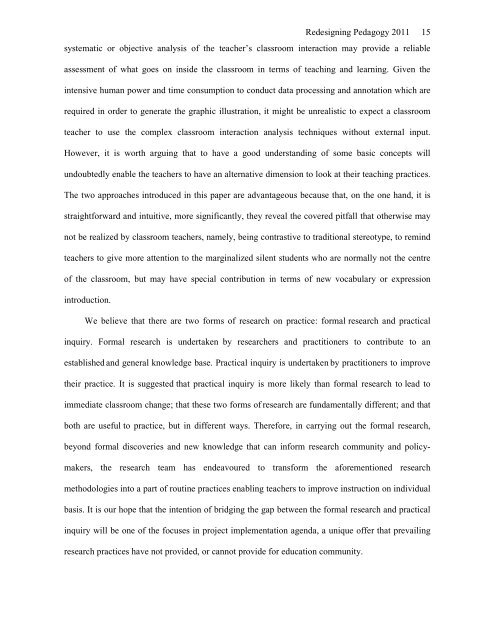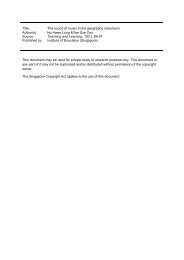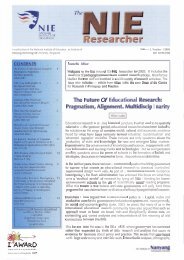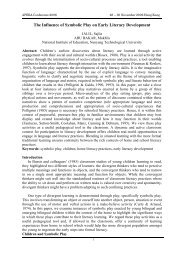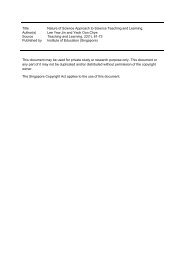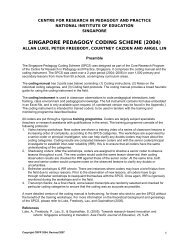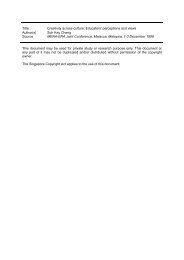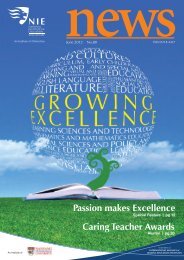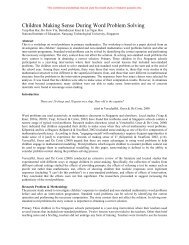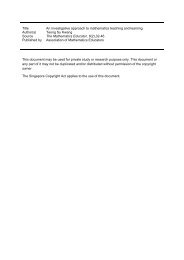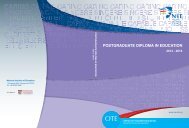Classroom interaction analysis techniques for classroom teachers ...
Classroom interaction analysis techniques for classroom teachers ...
Classroom interaction analysis techniques for classroom teachers ...
You also want an ePaper? Increase the reach of your titles
YUMPU automatically turns print PDFs into web optimized ePapers that Google loves.
Redesigning Pedagogy 2011 15systematic or objective <strong>analysis</strong> of the teacher’s <strong>classroom</strong> <strong>interaction</strong> may provide a reliableassessment of what goes on inside the <strong>classroom</strong> in terms of teaching and learning. Given theintensive human power and time consumption to conduct data processing and annotation which arerequired in order to generate the graphic illustration, it might be unrealistic to expect a <strong>classroom</strong>teacher to use the complex <strong>classroom</strong> <strong>interaction</strong> <strong>analysis</strong> <strong>techniques</strong> without external input.However, it is worth arguing that to have a good understanding of some basic concepts willundoubtedly enable the <strong>teachers</strong> to have an alternative dimension to look at their teaching practices.The two approaches introduced in this paper are advantageous because that, on the one hand, it isstraight<strong>for</strong>ward and intuitive, more significantly, they reveal the covered pitfall that otherwise maynot be realized by <strong>classroom</strong> <strong>teachers</strong>, namely, being contrastive to traditional stereotype, to remind<strong>teachers</strong> to give more attention to the marginalized silent students who are normally not the centreof the <strong>classroom</strong>, but may have special contribution in terms of new vocabulary or expressionintroduction.We believe that there are two <strong>for</strong>ms of research on practice: <strong>for</strong>mal research and practicalinquiry. Formal research is undertaken by researchers and practitioners to contribute to anestablished and general knowledge base. Practical inquiry is undertaken by practitioners to improvetheir practice. It is suggested that practical inquiry is more likely than <strong>for</strong>mal research to lead toimmediate <strong>classroom</strong> change; that these two <strong>for</strong>ms of research are fundamentally different; and thatboth are useful to practice, but in different ways. There<strong>for</strong>e, in carrying out the <strong>for</strong>mal research,beyond <strong>for</strong>mal discoveries and new knowledge that can in<strong>for</strong>m research community and policymakers,the research team has endeavoured to trans<strong>for</strong>m the a<strong>for</strong>ementioned researchmethodologies into a part of routine practices enabling <strong>teachers</strong> to improve instruction on individualbasis. It is our hope that the intention of bridging the gap between the <strong>for</strong>mal research and practicalinquiry will be one of the focuses in project implementation agenda, a unique offer that prevailingresearch practices have not provided, or cannot provide <strong>for</strong> education community.


